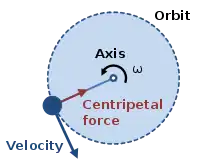For an object accelerating in circular motion, the unbalanced force acting on the object equals:
With
- . Centripetal Force
- . Mass
- . Speed
- . Radius of circle
where is the mass of the object, is the velocity of the object and is the distance to the center of the circular path and is the unit vector pointing in the radial direction outwards from the center. This means that the unbalanced centripetal force felt by any object is always directed toward the center of the curving path. Such forces act perpendicular to the velocity vector associated with the motion of an object, and therefore do not change the speed of the object (magnitude of the velocity), but only the direction of the velocity vector. The unbalanced force that accelerates an object can be resolved into a component that is perpendicular to the path, and one that is tangential to the path. This yields both the tangential force, which accelerates the object by either slowing it down or speeding it up, and the radial (centripetal) force, which changes its direction.
